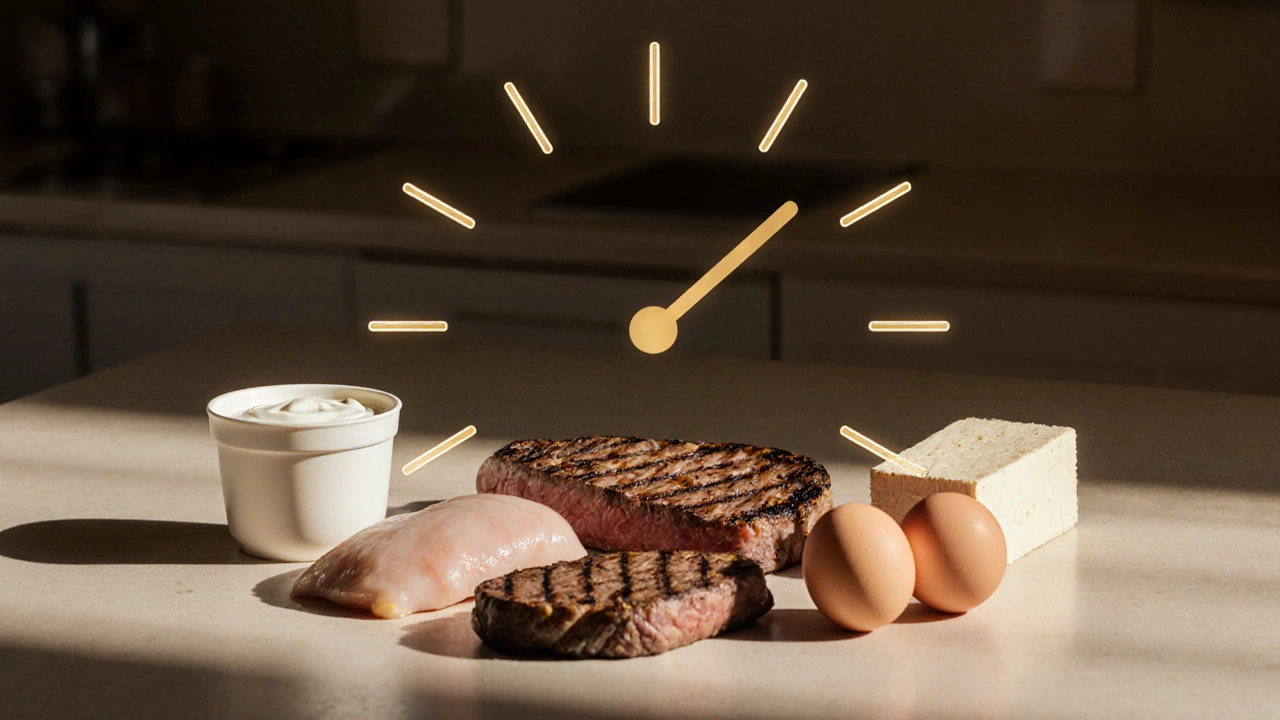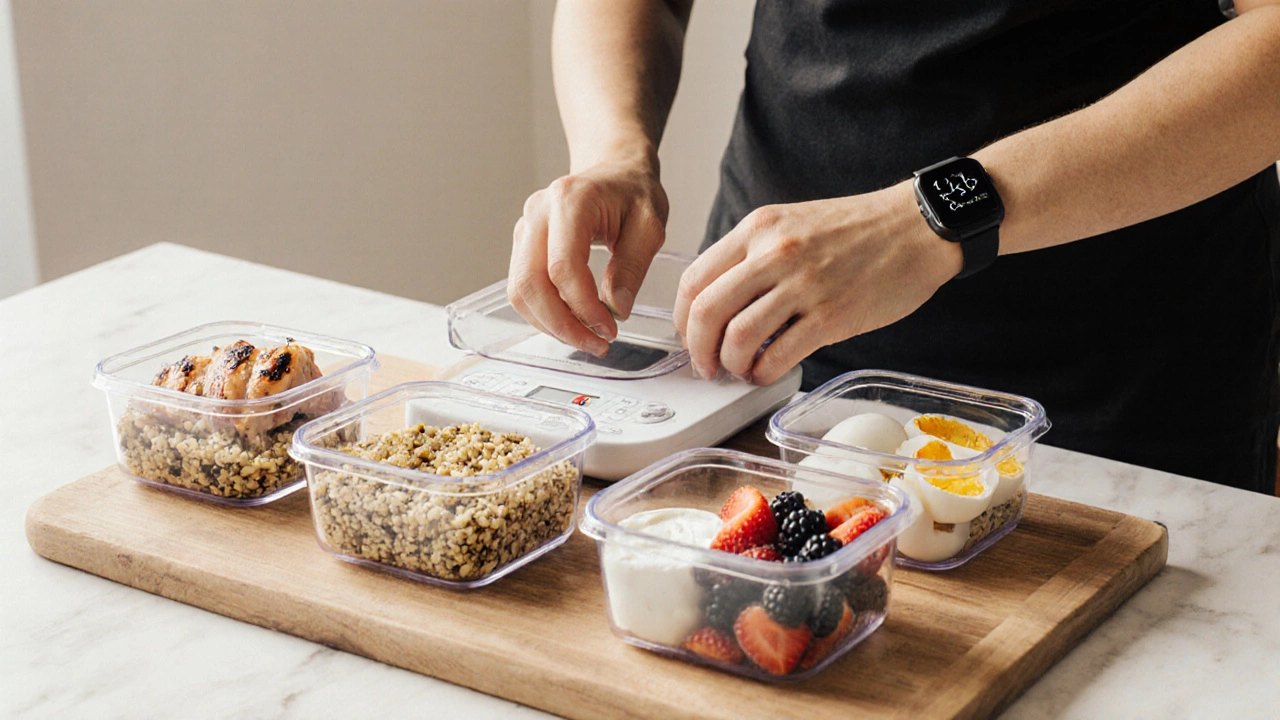Protein Needs on Rest Days for Strength Training
 Oct, 17 2025
Oct, 17 2025
Rest Day Protein Calculator
Calculate your optimal protein intake for muscle recovery on rest days based on your body weight, training level, and calorie goals.
Protein Recommendation: g/day
Per Meal Target: 20-30 g per meal (spread across 3-4 meals)
Leucine Check: Aim for 2-3g leucine per meal from foods like dairy, meat, and soy
How to use this: Divide your total protein by 3-4 meals to get your target per meal. Include leucine-rich foods to maximize muscle protein synthesis.
You've been grinding hard in the gym, hitting heavy lifts and chasing strength gains. But what happens when you take a day off? Do you still need to consume the same amount of protein, or can you cut back until the next workout? The short answer: yes, you still need protein, but the amount can be fine‑tuned based on your activity level, total calories, and recovery goals.
Key Takeaways
- Rest‑day protein should cover daily muscle maintenance and repair, typically 0.8‑1.0g perkg body weight.
- If you’re in a calorie surplus or cutting, adjust by ±10‑20%.
- Leucine‑rich foods (e.g., dairy, meat, soy) help keep muscle protein synthesis (MPS) active on off‑days.
- Spread protein across 3‑4 meals; aim for 20‑30g per serving to maximize MPS.
- Track your intake with a simple app or spreadsheet to stay consistent.
When figuring out protein intake is the amount of protein you consume each day to support muscle repair and growth, you’ll often hear the phrase “protein on rest days.” protein on rest days isn’t a myth; it’s a practical tool to keep muscle tissue from breaking down while you’re not training.
Why Protein Still Matters on Rest Days
Even when you’re not lifting, your body continues to break down and rebuild muscle proteins. This turnover is called muscle protein turnover, and it’s driven by three main processes:
- Muscle protein synthesis (the building phase that repairs micro‑tears caused by resistance training)
- Muscle protein breakdown (the natural catabolic process that recycles old proteins)
- Net protein balance (the difference between synthesis and breakdown; positive balance leads to growth)
On training days, the stimulus from heavy lifts spikes MPS, and you feed it with protein to push the net balance positive. On rest days, the stimulus drops, but MPS doesn’t disappear completely-it just runs at a lower baseline. Supplying enough protein keeps the balance from swinging negative, which would erode the gains you worked for.
How to Calculate Your Rest‑Day Protein Target
Start with your body weight in kilograms. Multiply by a range that reflects your training experience and goals:
- Beginners/General fitness: 0.8g/kg
- Intermediate strength athletes: 1.0g/kg
- Advanced lifters aiming for hypertrophy: 1.2g/kg (you can keep this on rest days if you’re in a calorie surplus)
For example, a 85kg (187lb) lifter at the intermediate level would aim for 85g of protein on a rest day. If you’re cutting and want to preserve lean mass, bump that up by 10% to around 94g.
Leucine and the Amino Acid Profile
Not all proteins are created equal. Leucine, an essential branched‑chain amino acid (BCAA), acts like a trigger for MPS. Research shows that hitting about 2-3g of leucine per meal maximizes the anabolic response.
Foods with a high leucine density include:
- Greek yogurt (≈1.3g leucine per 100g)
- Lean beef (≈1.8g per 100g)
- Eggs (≈1.1g per 2 large eggs)
- Soy isolates (≈1.5g per 100g)
Choosing at least one leucine‑rich source in each rest‑day meal helps keep MPS ticking over, even without the workout‑induced spike.

Meal Timing on Off‑Days
While you don’t need to worry about pre‑ and post‑workout windows on rest days, spreading protein evenly still matters. Aim for 20‑30g of high‑quality protein every 3‑4hours. This strategy ensures a steady supply of amino acids for repair.
Here’s a sample schedule for a 75kg lifter targeting 75g protein:
- 07:30am - 25g whey protein shake (≈2g leucine)
- 12:00pm - 30g grilled chicken breast + quinoa
- 04:30pm - 20g Greek yogurt with berries
- 08:00pm - Optional 10g casein if total falls short
This pattern keeps plasma amino acid levels elevated, supporting continuous repair.
Caloric Balance and Protein Adjustments
Your overall calorie intake influences how protein is used. In a surplus, excess calories spare protein from being used for energy, allowing you to focus on building. In a deficit, the body may oxidize more protein for fuel, so you might increase protein by 10‑20% to protect lean mass.
Factor in the caloric balance (the relationship between calories consumed and expended) when tweaking your rest‑day numbers.
Comparison: Training Day vs. Rest Day Protein
| Day Type | Protein (g/kg body weight) | Total Protein (g) | Key Considerations |
|---|---|---|---|
| Training Day | 1.2-1.4 | 96-112 | Spread 4‑5 meals, prioritize leucine post‑workout |
| Rest Day | 0.9-1.0 | 72-80 | Even distribution, keep leucine‑rich foods each meal |

Practical Tips to Stay Consistent
- Prep protein portions ahead of time (e.g., boiled eggs, grilled chicken, portioned cottage cheese).
- Use a simple tracking app; many let you set a daily protein goal and notify you when you’re behind.
- If you’re vegetarian, combine legumes with grains (e.g., lentils + brown rice) to hit a full amino‑acid profile.
- Don’t rely on protein bars alone; they often have added sugars that can affect recovery.
Common Pitfalls and How to Avoid Them
Pitfall 1: Assuming you can skip protein entirely on rest days.
Solution: Keep at least your baseline intake; muscle doesn’t “pause” its turnover.
Pitfall 2: Eating all protein in one mega‑meal.
Solution: Aim for 20‑30g per serving; the body can only use a limited amount at once.
Pitfall 3: Forgetting about leucine.
Solution: Include at least one high‑leucine source in each meal.
Frequently Asked Questions
Do I need more protein on rest days if I’m in a calorie deficit?
Yes. When you’re cutting calories, the body may tap protein for energy. Raising your rest‑day intake by 10‑20% (≈0.9g/kg) helps preserve lean mass while you lose fat.
Can plant‑based athletes meet rest‑day protein needs?
Absolutely. Combine soy, lentils, quinoa, and dairy alternatives. Aim for a variety of sources to hit a complete amino‑acid profile and watch leucine levels-about 2g per meal.
Is timing still important on a rest day?
While you don’t need a strict pre‑/post‑workout window, spacing protein every 3‑4hours keeps amino acids available for ongoing repair.
What if I miss a protein meal on a rest day?
One missed meal isn’t catastrophic. Just aim to meet your total daily goal; you can make up the shortfall with a snack later.
Should I use supplements on rest days?
Supplements like whey or casein are convenient, but whole‑food sources work just as well. If you’re struggling to hit your target, a protein shake can fill the gap.
Bottom line: Rest days aren’t a free pass to ignore nutrition. By keeping protein intake near your maintenance level and focusing on leucine‑rich meals, you protect the hard‑earned gains from your training sessions. Track, adjust, and stay consistent-your muscles will thank you.
